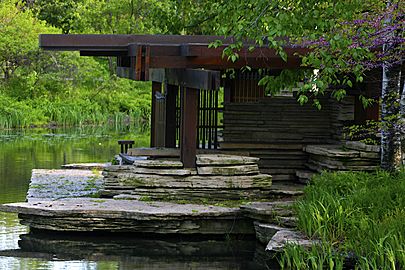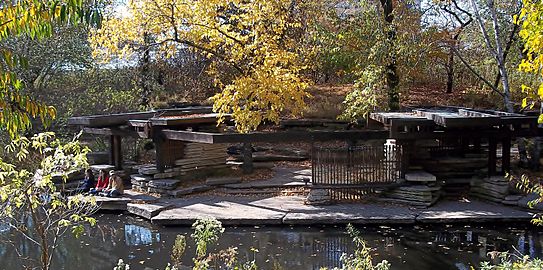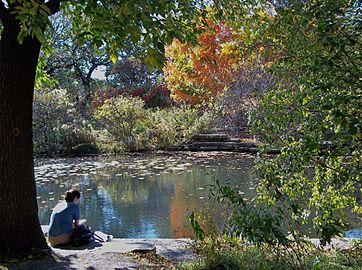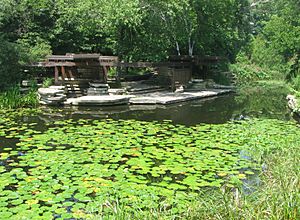Alfred Caldwell Lily Pool facts for kids
|
Lincoln Park Lily Pool
|
|
|
U.S. Historic district
Contributing property |
|
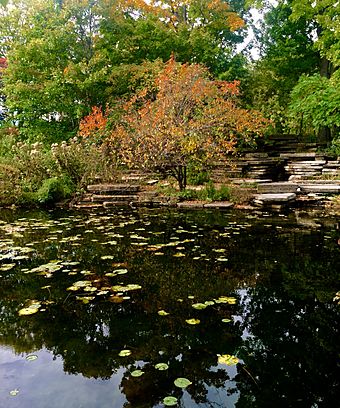 |
|
| Lua error in Module:Location_map at line 420: attempt to index field 'wikibase' (a nil value). | |
| Location | Fullerton Parkway between Cannon and Stockton Drives in Lincoln Park, Chicago, IL |
|---|---|
| Area | 3 acres (1.2 ha) |
| Architect | Alfred Caldwell |
| Part of | Lincoln Park (ID94001029) |
| NRHP reference No. | 06000235 |
Quick facts for kids Significant dates |
|
| Added to NRHP | February 17, 2006 |
| Designated NHLD | February 17, 2006 |
| Designated CP | August 26, 1994 |
The Alfred Caldwell Lily Pool, also known as Lincoln Park Lily Pool, is a beautiful garden in Lincoln Park, Chicago, Illinois. It's a great example of a special kind of garden design called Prairie School landscape architecture. The famous designer Alfred Caldwell created it between 1936 and 1938.
This lily pool is one of Caldwell's most complete and important designs. Because it's so special, it was named a Chicago Landmark in 2002. It was also added to the National Register of Historic Places and became a National Historic Landmark in 2006.
Contents
The Lily Pool's Story
How It Started
Back in 1889, there was an older lily pool here. It was built in a fancy Victorian style. The idea was to grow tropical water lilies, which are flowers that usually grow in warmer places. They even tried to heat the water to help the lilies grow.
But growing these lilies in Chicago's cold climate was tough. The pools often looked messy and were sometimes called "Pettigrew's frog ponds." By the 1930s, the whole area was run down.
Alfred Caldwell's Vision
That's when a talented landscape architect named Alfred Caldwell was hired. He worked for the Works Progress Administration (WPA), a government program that helped people find jobs during the Great Depression. Caldwell saw a chance to turn the old, messy pond into something truly special. He wanted to create a place that showed off his ideas about nature and design.
In 1938, as the project was almost finished, the park decided to cut costs. They didn't want to pay for wildflower plants. But Caldwell really believed in his vision. He used his own money, about $250, to buy thousands of plants. He brought them all the way from Wisconsin and, with the help of four friends, planted them around the lily pools. Today, the lily pool is located just north of the Lincoln Park Zoo and right next to the Lincoln Park Conservatory.
Special Features of the Design
Alfred Caldwell learned a lot from other famous designers. He worked with Jens Jensen, another landscape artist, for several years. Jensen's ideas can be seen in the Lily Pool's design:
- The "Sun Opening" or clearing, where sunlight can shine through.
- Curving paths and stepping-stone walkways made of limestone.
- Round benches that Jensen called "council rings" or "friendship circles." These benches were designed so everyone could sit equally, with no one in a "superior" spot.
The famous architect Frank Lloyd Wright also influenced the design. You can see his style in the natural-looking shelter and the main gate on Fullerton Parkway. These parts of the design fit right into the natural surroundings, just like Wright's "prairie-style" buildings.
A Time of Trouble
In the early 1950s, the lily pool changed. The zoo director at the time, Marlin Perkins, decided to use the pool for exotic birds and waterfowl. It became known as "The Rookery."
However, having so many zoo birds caused problems. They ate too much of the plants, and the garden started to suffer. Weeds and unwanted trees grew everywhere. People walking through the area also caused damage, and the soil started to wash away. New plants were brought in that didn't mix well with the lilies. All these issues made the pool look very bad. Alfred Caldwell himself said it had become "a dead world" in 1990.
Bringing It Back to Life
From 1998 to 2002, the Lily Pool got a big makeover. The Chicago Park District and the Lincoln Park Conservancy worked together to restore it. The Lincoln Park Conservancy (then called Friends of Lincoln Park) raised over a million dollars for the project. The USDA Forest Service also gave a large grant.
To make sure the restoration was done right, they talked to many different groups of people. These included:
- Experts in saving historic places.
- People who watch birds and study nature.
- People who knew a lot about Lincoln Park.
- Experts on making places easy for everyone to use.
- Members of the public.
Today, the Chicago Park District and the Lincoln Park Conservancy work together to take care of the Lily Pool. They also have a special program where volunteers called "docents" give tours.
Visiting the Lily Pool
The main entrance to the Lily Pool is on the south side of Fullerton Parkway. It's located between Stockton and Cannon Drives, at 125 W Fullerton Parkway.
The Lily Pool is open for visitors during certain times of the year. You can visit from mid-April to mid-November. It opens at 7:30 a.m. and closes at dusk or 7:30 p.m., whichever comes first.
If you want to learn more, you can take a free tour! Docent tours are available to the public on Fridays, Saturdays, or Sundays from spring through fall.
Images for kids
See Also


